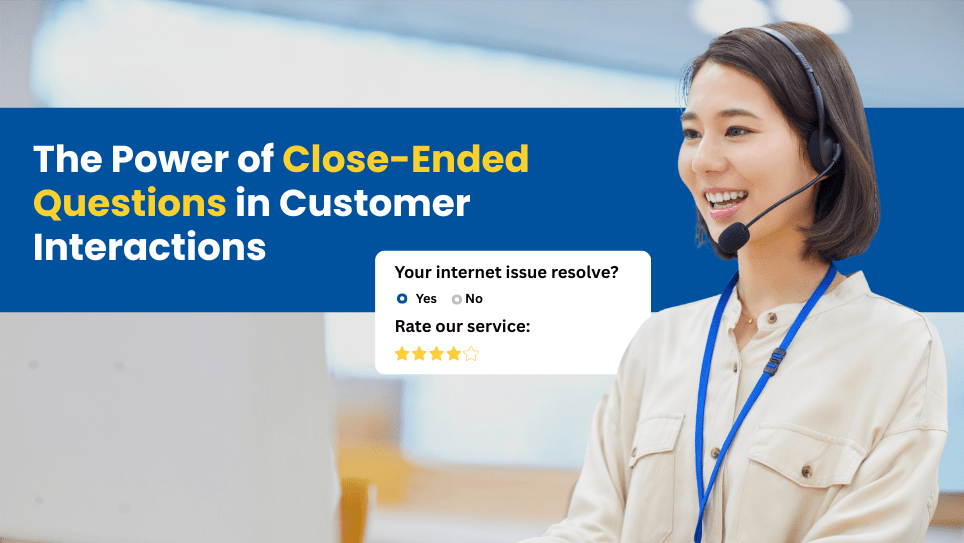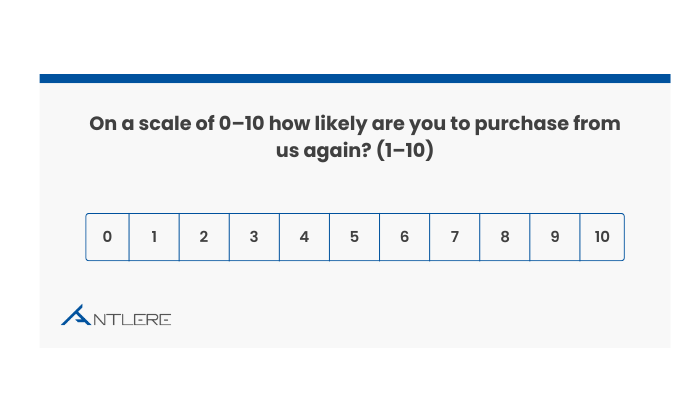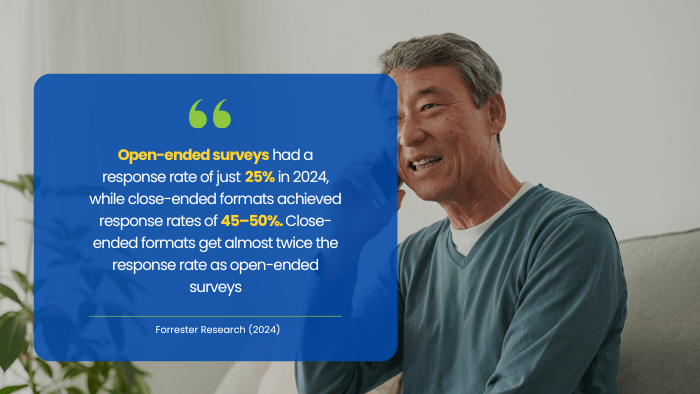

The Power of Close Ended Questions in Customer Interactions
Every customer interaction is essentially a conversation, and every conversation is shaped by the questions we ask. In customer service, research, and feedback collection, questions determine not just the information gathered but also the quality of engagement.
A support agent would essentially ask:
- What is your experience with our product? (Tell me everything.)
vs.
- How would you rate your experience as excellent, good, fair, or poor?
The first one is an open-ended question while the second one is an example of close ended questionnaire. Understanding the difference between these closed questions and their open-ended counterparts is key. The latter is open-ended with subjective results; the former is more structured, quantifiable, and clearer.
With every company dealing with millions of customer touchpoints across call centers, chatbots, social platforms, and feedback surveys today, the impact of close ended questions is impossible to ignore. These not only simplify interactions but also contribute to actionable insights.
What Are Close Ended Questions?
Close-ended questions, the foundation of what is a closed questionnaire, are formulated to record certain, pre-defined answers. These questions limit the customer to only choose between options like Yes/No, Multiple Choice, and Ratings instead of having to build a story response.
For example:
- Yes/No: “Would you recommend us to a friend? (This is a classic example of a dichotomous question and a common feature in a dichotomous questionnaire example.)
- MCQ: “What you put value on the most in features? (Speed, Price, Support, Quality)”
- After that comes an example of a NPS one which is: “On a scale of 0–10 how likely are you to purchase from us again? (1–10)”
It provides a level of consistency that can be a big advantage when conducting customer surveys, call center QA, and market research.

Why Close Ended Questions Are Essential for Businesses
In customer experience (CX), market intelligence, and contact center management, the use of close ended questions in research and business has become writ large. SurveyMonkey found (2024) that businesses who incorporated structured, close-ended feedback into decision-making saw a 29 percent boost in accuracy over those making decisions primarily based on open responses.
Their significance spans three levels:
- Time Saving: Less survey fatigue and less conversation time
- Comparative amenability: It helps the brands to compare up the customer reacts throughout the moment.
- Scalability: Supports analysis of hundreds of thousands of respondents.
Practical Examples: Open-Ended vs. Close Ended Questions in Action
Now, compare the same situation, presented a little differently.
Interaction Context | Open-Ended Example | Close-Ended Example | Advantage of Close-Ended |
Post-Purchase Feedback | “Write your review on our service.” | “How would you describe our service — Excellent, Good, Fair, Poor?” | Standardized measurement |
Call Center QA | “How well was your problem solved today?” | “Was your problem resolved in this call? (Yes/No)” | Binary clarity; a great closed questionnaire example. |
Product Feature Research | “What could we do better by our product here?” | “Would you prefer faster delivery or lower prices?” | Targeted insights |
Customer Loyalty Survey | “What is your reason to be loyal to our brand?” | “Would you refer us to a friend/coworker? (Yes/No)” | Measurable loyalty |
These closed ended questions examples underline how close-ended questions do not do away with insights but refine them into data points ready to become action.
The Role of Close Ended Questions in Customer Experience Transformation
Customer interactions are harder than ever to navigate nowadays. Businesses are spread out over chatbots, call facilities, social media, mobile applications, and in shops. In this kind of omnichannel ecosystem, one thing is clear.
A Zendesk CX Report (2024) highlights that:
- 73% of customers expect companies to personalize their experience.
- Companies using structured feedback methods like close-ended questions were 25% more likely to act on customer insights than those relying solely on open-ended responses.
This further exemplifies the fact that closed-ended questions are the crux of digital experience analytics, call center productivity and survey correctness.
Advantages of Close Ended Questions in Customer Interactions
If open-ended questions, where the open ended questions meaning is to allow for storytelling, the precision is unlocked with close-ended questions. Businesses benefit in multiple ways:
- Quickness and Effectiveness: Shoppers don’t take a whole bunch of time to write responses.
- Boost Engagement: Short, straightforward closed questions increase survey completion rates.
- Consistent Comparison: Standardized responses allow for tracking overtime.
- Actionable Data: Responses can be plugged into analytics dashboards for insights over time.
- Decreased Cognitive Burden: Customers need to put less work into selecting a pre-determined response.

Case Study: Close Ended Questions in Call Centers
Let us take a call center that wants to calculate First Call Resolution (FCR). Rather than having to ask customers to articulate why they are satisfied, agents can ask a series of sample closed ended questions, such as:
“Did we help you, today, solve your issue? (Yes/No)”
“How clear is our support? On a scale of 1–10”
The call center can begin assessing satisfaction rates, pinpointing areas of concern, and coaching agents within a matter of weeks. In contrast, open-ended responses would need to be manual scored and be subjectively evaluated, making it more difficult to make decisions quicker.
image
When to Use Close Ended Questions (and When Not To)
Close ended questions are helpful in tightly controlled feedback environments like satisfaction surveys, market research polls, call center reviews, etc. This is especially useful when time is of the essence, or when there is a large scale of data to be analyzed.
These tools may fail when it comes to the subtle emotional inflections or surprise reactions. For instance, one of the most common example closed questions is asking a customer, “Was your delivery on time?” A simple “Yes/No” will not tell you if the package was broken or if the delivery boy was ill-mannered.
The best method, though, is a combination of both, begin by asking a few close-ended questions to guide the customer and follow up with one or two open-ended questions to create the space for them to explain in detail.
Ethical Considerations in Designing Close Ended Questions
Not all closed ended questions are made equal. Customer responses to poorly designed questions are biased and lead to distorted insights. An example would include: “How satisfied are you with our gold standard service. In this way, it already proposes an affirmative answer to the consumer.
Companies must ensure:
- Be Neutral – It shouldn’t be worded like a leading phrase.
- Balanced Options – Provide a spectrum of responses, not merely positive ones.
- Be transparent – Be clear about how the data is going to be used.
It is important to adhere to those principles; otherwise, we have the data, but customers will lose trust.
The Future of Close Ended Questions in a Data-Driven World
Many organizations are already leveraging AI, predictive analytics, and customer journey mapping to enrich the information that close-ended questions provide us about the customers, and this trend will soon see a widespread increase. Today, voice analytics tools powered by AI or NLP extract Yes/No and scale-driven responses on the fly and populate dashboards with your findings in real-time, revolutionizing the use of closed questions in research.
That said, as per Gartner, 75% of customer interaction analytics will be driven by structured data captured via close-ended formats by 2026 thereby underlining the increasing contribution of close-ended formats to the sphere of CX.
Conclusion: Powering Precision with Antlere Smart
These examples of closed questions may appear deceptively simple but greatly affect customer experience, data authenticity, and strategic direction. Providing clarity in an ambiguous world, answering at the speed of time, and assembling decision-centric knowledge when time compels the business to act.
The truth is that we live in a hyper-competitive world today, throwaway approaches with the same knock-on effects no longer have a place. Brands that strike a neat balance between the quantitative precision of close-ended feedback and the qualitative richness of open-ended insights will be the ones at the helm.
This balance is no longer guesswork with Antlere Smart, it comes prebuilt as part of each customer interaction. Antlere goes beyond just collecting data smartly designing and deploying the right questions to the right touchpoints for you to shape journeys, drive loyalty and unlock growth.
The right questions do not merely gather answers, they mark the destiny of customer experience.



